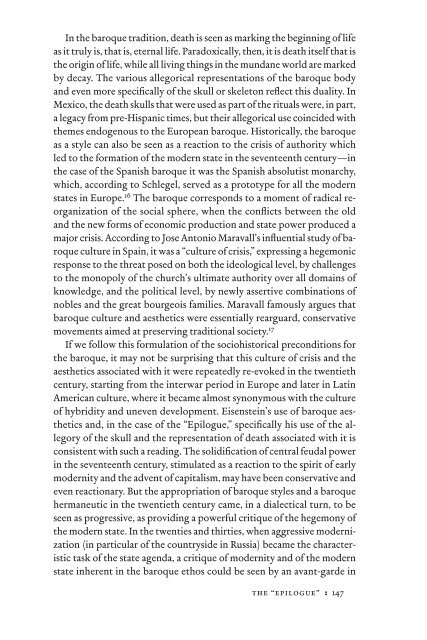In Excess: Sergei Eisentein's Mexico - Cineclub
In Excess: Sergei Eisentein's Mexico - Cineclub
In Excess: Sergei Eisentein's Mexico - Cineclub
Create successful ePaper yourself
Turn your PDF publications into a flip-book with our unique Google optimized e-Paper software.
<strong>In</strong> the baroque tradition, death is seen as marking the beginning of life<br />
as it truly is, that is, eternal life. Paradoxically, then, it is death itself that is<br />
the origin of life, while all living things in the mundane world are marked<br />
by decay. The various allegorical representations of the baroque body<br />
and even more specifi cally of the skull or skeleton refl ect this duality. <strong>In</strong><br />
<strong>Mexico</strong>, the death skulls that were used as part of the rituals were, in part,<br />
a legacy from pre-Hispanic times, but their allegorical use coincided with<br />
themes endogenous to the European baroque. Historically, the baroque<br />
as a style can also be seen as a reaction to the crisis of authority which<br />
led to the formation of the modern state in the seventeenth century—in<br />
the case of the Spanish baroque it was the Spanish absolutist monarchy,<br />
which, according to Schlegel, served as a prototype for all the modern<br />
states in Europe. 16 The baroque corresponds to a moment of radical reorganization<br />
of the social sphere, when the confl icts between the old<br />
and the new forms of economic production and state power produced a<br />
major crisis. According to Jose Antonio Maravall’s infl uential study of baroque<br />
culture in Spain, it was a “culture of crisis,” expressing a hegemonic<br />
response to the threat posed on both the ideological level, by challenges<br />
to the monopoly of the church’s ultimate authority over all domains of<br />
knowledge, and the political level, by newly assertive combinations of<br />
nobles and the great bourgeois families. Maravall famously argues that<br />
baroque culture and aesthetics were essentially rearguard, conservative<br />
movements aimed at preserving traditional society. 17<br />
If we follow this formulation of the sociohistorical preconditions for<br />
the baroque, it may not be surprising that this culture of crisis and the<br />
aesthetics associated with it were repeatedly re-evoked in the twentieth<br />
century, starting from the interwar period in Europe and later in Latin<br />
American culture, where it became almost synonymous with the culture<br />
of hybridity and uneven development. Eisenstein’s use of baroque aesthetics<br />
and, in the case of the “Epilogue,” specifi cally his use of the allegory<br />
of the skull and the representation of death associated with it is<br />
consistent with such a reading. The solidifi cation of central feudal power<br />
in the seventeenth century, stimulated as a reaction to the spirit of early<br />
modernity and the advent of capitalism, may have been conservative and<br />
even reactionary. But the appropriation of baroque styles and a baroque<br />
hermaneutic in the twentieth century came, in a dialectical turn, to be<br />
seen as progressive, as providing a powerful critique of the hegemony of<br />
the modern state. <strong>In</strong> the twenties and thirties, when aggressive modernization<br />
(in particular of the countryside in Russia) became the characteristic<br />
task of the state agenda, a critique of modernity and of the modern<br />
state inherent in the baroque ethos could be seen by an avant-garde in<br />
the “epilogue” : 147


